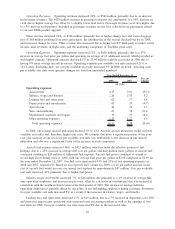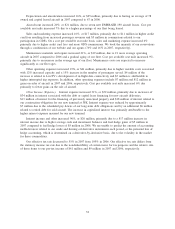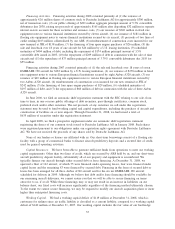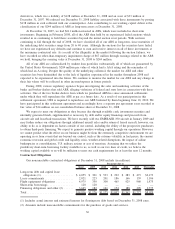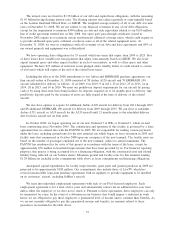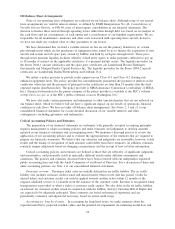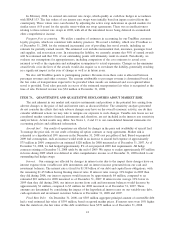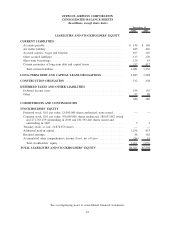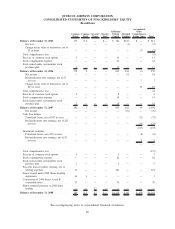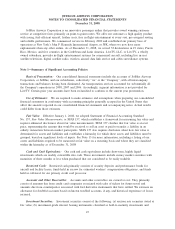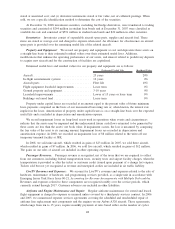JetBlue Airlines 2008 Annual Report Download - page 48
Download and view the complete annual report
Please find page 48 of the 2008 JetBlue Airlines annual report below. You can navigate through the pages in the report by either clicking on the pages listed below, or by using the keyword search tool below to find specific information within the annual report.residual values of our aircraft, we have relied upon actual industry experience with the same or similar aircraft
types and our anticipated utilization of the aircraft. Changing market prices of new and used aircraft, government
regulations and changes in our maintenance program or operations could result in changes to these estimates.
The amortization of our purchased technology, which resulted from our acquisition of LiveTV in 2002, is based
on the average number of aircraft in service and expected to be in service as of the date of their acquisition. This
method results in an increasing annual expense through 2009 when the last of these aircraft are expected to be
placed into service and is adjusted to reflect changes in our contractual delivery schedule.
Our long-lived assets are evaluated for impairment at least annually or when events and circumstances
indicate that the assets may be impaired. Indicators include operating or cash flow losses, significant decreases in
market value or changes in technology. As our assets are all relatively new and we continue to have positive
cash flow, we have not identified any significant impairments related to our long-lived assets at this time.
Stock-based compensation. The adoption of SFAS 123(R) in 2006 required the recording of stock-based
compensation expense for issuances under our stock purchase plan and stock incentive plan over their requisite
service period using a fair value approach similar to the pro forma disclosure requirements of Statement of
Financial Accounting Standards No. 123, Accounting for Stock-Based Compensation, or SFAS 123. We use a
Black-Scholes-Merton option pricing model to estimate the fair value of share-based awards under
SFAS 123(R), which is the same valuation technique we previously used for pro forma disclosures under
SFAS 123. The Black-Scholes-Merton option pricing model incorporates various and highly subjective
assumptions. We estimate the expected term of options granted using an implied life derived from the results
of a lattice model, which incorporates our historical exercise and post-vesting cancellation patterns, which we
believe are representative of future behavior. The expected term of restricted stock units is based on the
requisite service period of the awards being granted. The expected term for our employee stock purchase plan
valuation is based on the length of each purchase period as measured at the beginning of the offering period.
We estimate the expected volatility of our common stock at the grant date using a blend of 75% historical
volatility of our common stock and 25% implied volatility of two-year publicly traded options on our common
stock as of the option grant date. Our decision to use a blend of historical and implied volatility was based
upon the volume of actively traded options on our common stock and our belief that historical volatility alone
may not be completely representative of future stock price trends. Regardless of the method selected,
significant judgment is required for some of the valuation variables. The most significant of these is the
volatility of our common stock and the estimated term over which our stock options will be outstanding. The
valuation calculation is sensitive to even slight changes in these estimates.
Lease accounting. We operate airport facilities, offices buildings and aircraft under operating leases with
minimum lease payments associated with these agreements recognized as rent expense on a straight-line basis
over the expected lease term. Within the provisions of certain leases there are minimum escalations in
payments over the base lease term, as well as renewal periods. The effects of the escalations have been
reflected in rent expense on a straight-line basis over the lease term, which includes renewal periods when it is
deemed to be reasonably assured that we would incur an economic penalty for not renewing. The amortization
period for leasehold improvements is the term used in calculating straight-line rent expense or their estimated
economic life, whichever is shorter. Had different conclusions been reached with respect to the lease term and
related renewal periods, different amounts of amortization and rent expense would have been reported.
Derivative instruments used for aircraft fuel. We utilize financial derivative instruments to manage the
risk of changing aircraft fuel prices. We do not purchase or hold any derivative instrument for trading
purposes. At December 31, 2008, we had a $128 million liability related to the net fair value of our derivative
instruments. The majority of our financial derivative instruments are not traded on a public exchange. Fair
values are assigned based on commodity prices that are provided to us by independent third parties. When
possible, we designate these instruments as cash flow hedges for accounting purposes, as defined by Statement
of Financial Accounting Standards No. 133, Accounting for Derivative Instruments and Hedging Activities, or
SFAS 133, which permits the deferral of the effective portions of gains or losses until contract settlement.
SFAS 133 is a complex accounting standard, requiring that we develop and maintain a significant amount
of documentation related to (1) our fuel hedging program and strategy, (2) statistical analysis supporting a
highly correlated relationship between the underlying commodity in the derivative financial instrument and the
39


